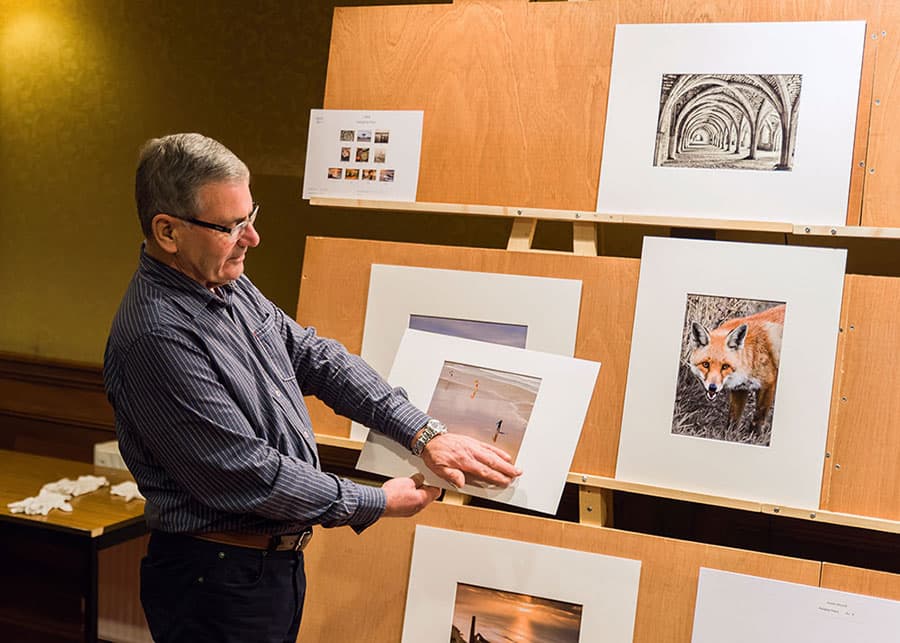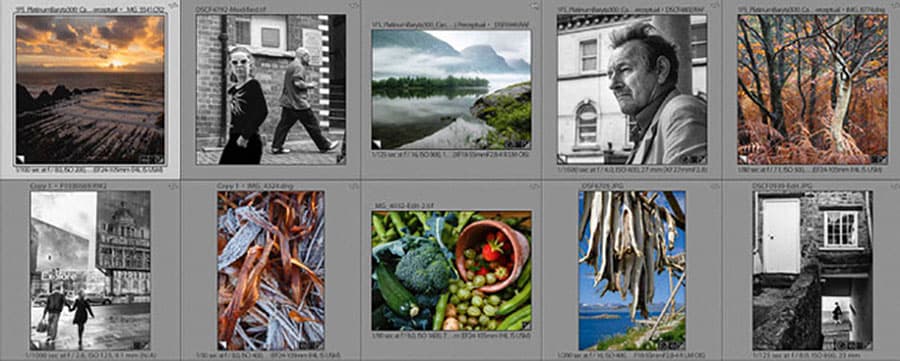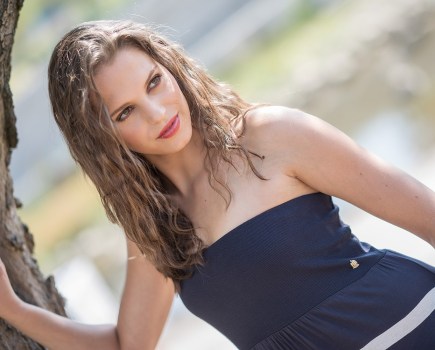
Advisory days offer a great chance to get informal feedback on your proposed panel from highly experienced assessors. Credit: Geoff Harris
How does an amateur gauge the level of his/ her photography? You can try to sell images commercially, which has become a lot more difficult; enter your pictures in competitions, which have become a lot more, well, competitive; or try to get some kind of camera club or photographic society ‘distinction’. Basically this is where a group of experienced peers judge a selection or panel of your images to see if they meet the required standard for a particular distinction or qualification. The pioneer of this process in the UK is the Royal Photographic Society (founded in 1853), which offers three popular distinctions – the Licentiateship (LRPS), the more demanding Associateship (ARPS), and the highly prized Fellowship (FRPS). While having these letters after your name won’t necessarily raise your profile or help you sell more pictures, working through the distinction process can be very rewarding, while also helping you to focus on areas for improvement. It also gives you something to aim for; you could put strong images to use, which might otherwise languish on a hard drive or yesterday’s social media posts. It can also motivate you to learn new skills.
Cream of Devon
While it may be a first step, the Licentiateship – or ‘L’ – is far from a formality. You need to demonstrate solid technical skills and a creative eye. The Associateship – or ‘A’ – requires you to show creative ability and personal style, along with complete control of the technical aspects of photography. But to make the process less daunting, the RPS organises regular advisory days, where members can present their chosen images for informal feedback and advice. The Western Region recently held such a day in Devon for L and A candidates, so I went along to see what happens.
The day unfolded in a hotel in Bovey Tracey near Exeter, and the venue soon became packed with people either presenting panels or observing. After a short introduction, the two guest assessors – Susan Brown and Peter Paterson, both FRPS heavy-hitters – introduced themselves. Most advisory days follow a similar format, kicking off with a discussion of why previously successful L and A panels made the grade. The assessors then scrutinised about 10 panels from attendees, which they had never seen before, with a break for lunch. They gave constructive feedback, chatting with the photographer if present and answering questions from the audience. The atmosphere was focused, but friendly and supportive. Once the day is done, candidates have time to change or tweak their panels before the RPS assessment day. While there is no guarantee they will pass, the candidates should have a clearer idea of what they need to do – and the RPS maintains that candidates who have attended such days tend to do much better.
Associate-level candidates can base their images around a specific genre (e.g. travel, natural history, science or fine art). But Licentiate candidates in some ways have a slightly tougher job as they need to show variety in approach and techniques but not necessarily in subject matter. So, rather than looking for a variety of subjects (say a seascape next to an insect macro), assessors look for a variety of approaches: the use of different lenses, shutter speeds, aperture, movement and so on. Some of the L panels on the day incorporated two images of similar subjects, but this wasn’t a problem as they had demonstrated varied approaches. This is not to say an Associateship is somehow easier: candidates have to supply 15 images (it’s 10 for the L), that are scrutinised in exacting detail by sharp-eyed pundits.
Indeed, images that get you a polite round of applause at your camera club or even win a contest might not be so well received by RPS assessors, who are working to strict and consistent national standards. This is why it’s a valued distinction.

All aspects of proposed images are scrutinised, as well as how well the entire panel hangs together. Credit: Geoff Harris
My handsome prints
On the subject of quality, it soon became clear that the RPS assessors have little tolerance for common technical howlers, such as blown-out highlights/lost shadow detail, unsharp images or ham-fisted editing. At both L and A levels, seriously blown-out highlights and blocks of undifferentiated shadow are apparently major reasons for failure. At Fellowship level, meanwhile, such sins wouldn’t even get you through the door. As for sharpness, images should be pin-sharp where they need to be (on the eyes of a portrait, for example), or there needs to be deliberate creative movement and blur. ‘Don’t leave assessors wondering if you got it right or not,’ says Peter Paterson, while emphasising that over-sharpening will be penalised, too. This is one of the key advantages of attending the advisory day: although the guest assessors on the day won’t be judging your final panel, they can easily spot potential problems, allowing you time to fix them or find alternative images.
Another key teaching point was the concept of the ‘11th’ image. An L panel comprises 10 images and an A panel 15, so the 11th is the hanging plan – how well the printed images hang together as a cohesive unit. So the assessors gave a lot of attention to the order of images in panels, changing the layout for a more pleasing ‘whole’. As Susan Brown pointed out, it is crucial that your panel makes a good first impression as the actual assessors look at it from a distance and then move in. She also recommended that candidates don’t print any bigger than A4 – larger sizes can make technical issues such as softness or noise more obvious, while smaller will invite extra scrutiny. Mixing mount sizes tends to be frowned upon too, as it can look inconsistent. Candidates don’t have to supply prints; digital images are also accepted but this is quite risky unless you have a fully calibrated digital projector, as used by the RPS. Any faults in your image will also be blown-up big for all to see.
Other issues to watch out for include cluttered compositions with distracting backgrounds, and overly aggressive cropping which makes the subject feel ‘cramped’ – this was a particular problem with wildlife images on the Devon day. The occasional wonky horizon was pointed out, too. When it comes to editing, some ‘gardening’ with software to get rid of distractions is allowed, but heavy comping or image manipulation is not (this depends on the category you are going for at A level, however). A mixture of black & white and colour is acceptable in both L and A panels, so long as the mono conversion is well-executed, and the cohesion and balance of the panel as a whole is maintained. Again, the only way to see if your mix of mono and colour works is to get feedback from an experienced assessor.

Candidates can also bring along ‘spare’ images, which sometimes end up in the final panel following the advisory day. Credit: Geoff Harris
Worth a shot
I should probably disclose at this point that I got my LRPS in 2014, so I have a good understanding of what the process involves. Getting my L was not easy, but having to think so carefully about so many aspects of image making and print presentation definitely helped my photography to evolve (and before any cynics chip in, it’s an anonymous process, so the panel had no idea I worked on magazines).
Of course, the RPS is not the only game in town, and photographers working professionally in particular genres, such as weddings, might prefer to get a distinction from a specialist body, such as the Society of Wedding and Portrait Photographers (SWPP) or Master Photographers Association (MPA). For more generalist photographers, however, who are keen to see what level their work is at, or need a bit of extra motivation to get out there with their camera, doing an RPS distinction would be very sound idea – and the qualification is recognised all over the world.
Two LRPS contenders share their experience of the advisory day

David’s bold architecture shot shows variety of approach. Credit: David Rudge
David Rudge
‘I approached the LRPS advisory day as another milestone along my journey to become a better photographer. I find that there is nothing more challenging than placing your work under the scrutiny of expert eyes, and this should always be taken as a learning experience be it at a club or national forum. The advisory day turned out to be invaluable in many ways. There were positives that included recognition that my panel provided a good spread of different types of techniques with some good and interesting images. However, and more importantly, the more critical comments provided me with a greater insight into how all images can be improved both in the environment in which they are captured (a grain of dust on the lens of one image didn’t help!) and how they could be developed further with software. It was clear that a successful LRPS panel needs to contain 10 images of a high standard that demonstrate a variety of approaches that somehow come together as a cohesive whole – the 11th image. I now know what I need to do to improve.’

Even for the entry-level L distinction, exposure must be well controlled. Credit: Steve Jupp
Steve Jupp
‘I went along because I had tried for the Licentiateship a couple of years back and failed. Last time I didn’t seek advice from the people involved in the process, so this was a great opportunity to hear from the experts. I was first up and delighted to get a positive response to my panel: one image needed more contrast and one was not up to the standard, but I had a worthy replacement in reserve. I’ve now booked in again for the formal assessment at RPS HQ in Bath in February.
‘I’m grateful to my mentor for suggesting that I go for the ‘L’. It has given me a focus and aim which have really helped me to develop my photography and feel confident about handling the camera in all circumstances. If I am successful this time I am looking forward to going for my Associateship and … who knows what in the future!
‘I took up photography as a “serious amateur” when I retired from a very busy job in the NHS, and it has given me a focus and purpose which have been very valuable after retiring from full-time work. I love how time stands still when I am outdoors, either when shooting landscape or a city, with a camera around my neck.’

Steve Jupp was pleased to get some positive feedback on his panel at the advisory day. Credit: Steve Jupp







